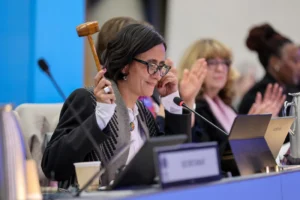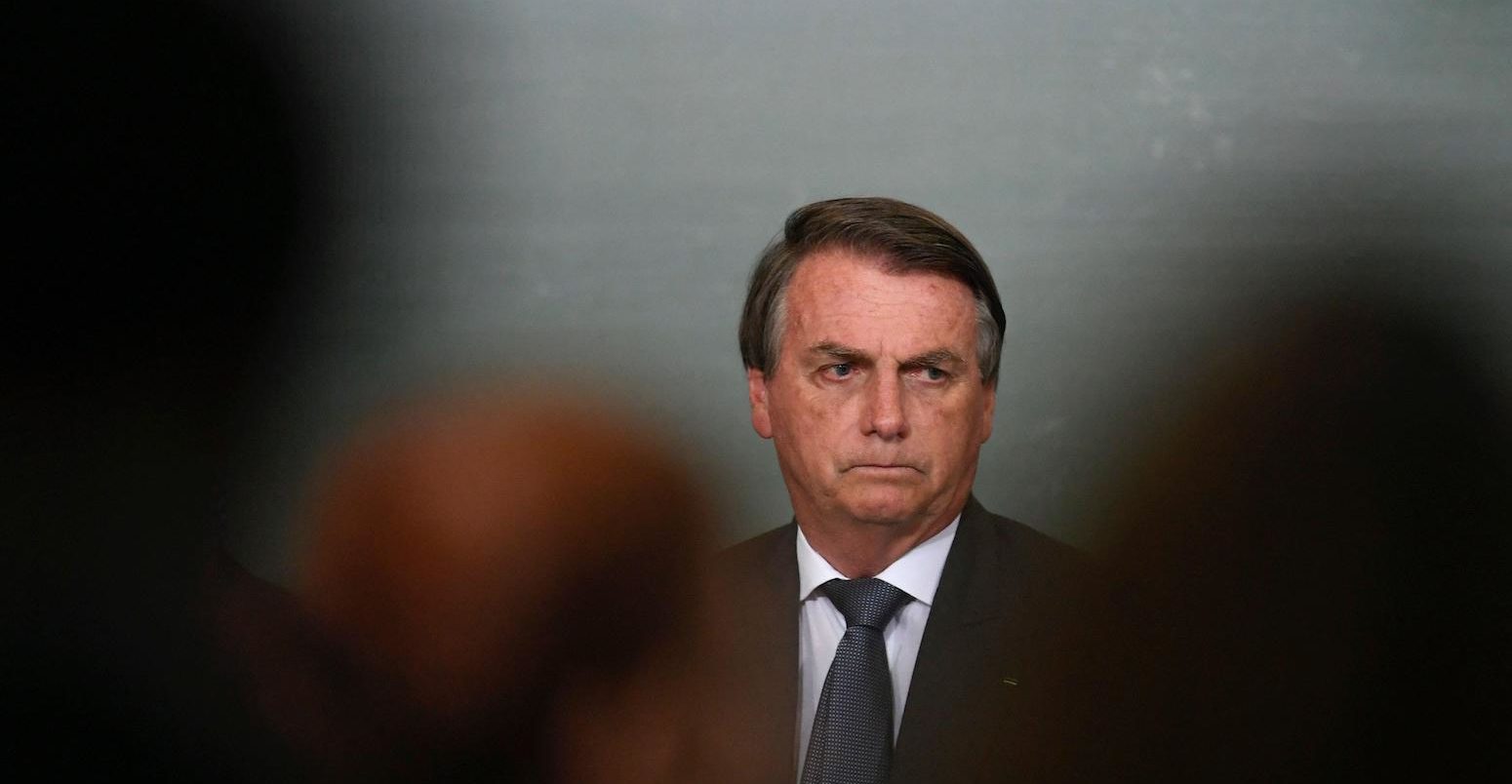
Analysis: Bolsonaro election loss could cut Brazilian Amazon deforestation by 89%
Josh Gabbatiss
09.23.22Josh Gabbatiss
23.09.2022 | 1:20pmA loss for Jair Bolsonaro in the upcoming Brazilian presidential election could lead to Amazon deforestation in his nation falling by 89% over the next decade, according to new analysis conducted for Carbon Brief.
A victory for left-wing challenger and current frontrunner Luiz Inácio Lula da Silva – commonly known as Lula – could avoid 75,960km2 of Amazon rainforest loss by 2030, the analysis shows – an area roughly the size of Panama. This would also significantly curb Brazil’s emissions when accompanied by a new focus on forest restoration.
This assumes that Lula would follow through on a pledge to address illegal deforestation in the Amazon, in line with his previous presidency, while Bolsonaro would continue to oversee weak environmental governance that allows such activities to continue. It also assumes these conditions would remain the same out to 2030.
The analysis, by researchers at the University of Oxford, the International Institute for Applied System Analysis (IIASA) and the National Institute for Space Research (INPE), models the implementation of Brazil’s Forest Code, the country’s flagship legislation for tackling deforestation in the Amazon and other ecosystems.
There are many factors that could influence the future of the Amazon, but the results highlight the impact that enforcing environmental legislation could have after years of neglect under Brazil’s current right-wing leader.
(31/10/2022: Lula has won a very slim majority in the second round of the presidential election, ousting Bolsonaro. In his victory speech, the veteran left-wing politician pledged to fight for zero deforestation and said he was open to international cooperation to protect the Amazon.)
Last month, Carbon Brief published analysis showing why an election loss by Bolsonaro could cut Brazilian Amazon deforestation by 89% | @Josh_Gabbatiss#Brazilelections#LulaPresidente2022 https://t.co/iForPOKQiA pic.twitter.com/Se3Eq0wWrU
— Carbon Brief (@CarbonBrief) October 31, 2022
Amazon election
Brazil is the world’s sixth-largest emitter of greenhouse gases, largely due to the carbon dioxide (CO2) emissions from deforestation and the methane from cattle pastures on cleared land. Its land-use emissions also make it the fourth-largest historical emitter.
By far the main driver of deforestation in the Brazilian Amazon is beef production, with soybeans for animal feed a distant second. The nation is the largest beef exporter in the world, primarily serving markets in China and the US.
All of this gives global significance to the Brazilian government’s approach to deforestation and big agribusiness expansion.
For the past four years since his election, right-wing president Bolsonaro has weakened existing environmental protections and legitimised illegal activity. As the chart below shows, deforestation in the Brazilian Amazon has increased since he took power, wiping out 34,018km2 of rainforest, an area larger than Belgium, in his first three years.
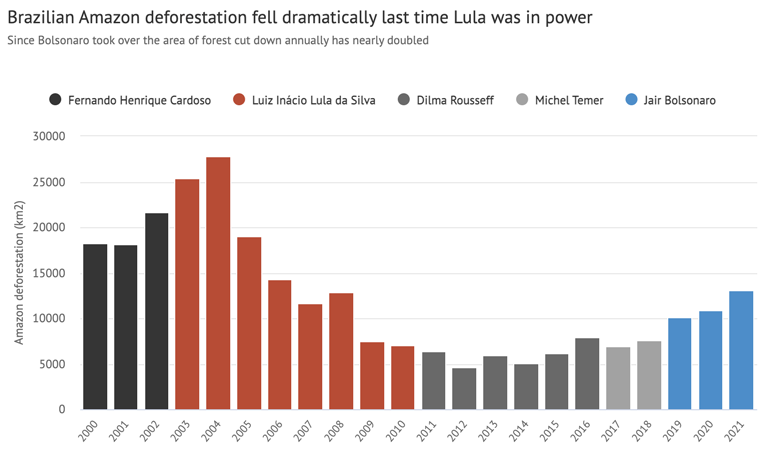
This is because, despite pledging to end illegal deforestation by 2030, in reality the president has thrown his support behind the nation’s powerful agricultural sector, allowing them to operate without restrictions and spread into Indigenous lands.
In contrast, between 2003 and 2010, when Lula was last president, deforestation in the Amazon fell by around three-quarters from a peak in 2004. Forest loss remained low under his fellow Workers’ Party politician Dilma Rouseff, who held the presidency until she was removed from office in 2016.
Lula, who is Bolsonaro’s main challenger in the upcoming presidential election after a spell in prison on controversial corruption charges, has published a manifesto referencing this past success. It notes that:
“In our governments, we have reduced deforestation by almost 80% in the Amazon, the largest contribution ever made by a country to mitigate climate change between 2004 and 2012.”
It adds that Lula intends to repeat these achievements, while mentioning plans to tackle illegal deforestation and invest in forest restoration.
With Brazil heading to the polls on 2 October, there are signs that a victory for Lula could see a reversal of the downward trend in environmental standards that has marked Bolsonaro’s time in office.
No Forest Code
To explore the implications of each presidential candidate winning the upcoming election, new analysis for Carbon Brief projects the future of the Brazilian Amazon under two different scenarios.
It is a refined update of a 2018 study that assessed the implementation of Brazil’s flagship Forest Code. It uses the GLOBIOM-Brazil model, which computes land-use change, while accounting for the production of dozens of agricultural products, global trade and various other factors, and its initial land-use data comes from MapBiomas.
The Forest Code, first introduced in 1965, remains Brazil’s main law to reduce deforestation. It requires landowners to preserve a certain proportion of forest on their property and restore land that has been illegally deforested.
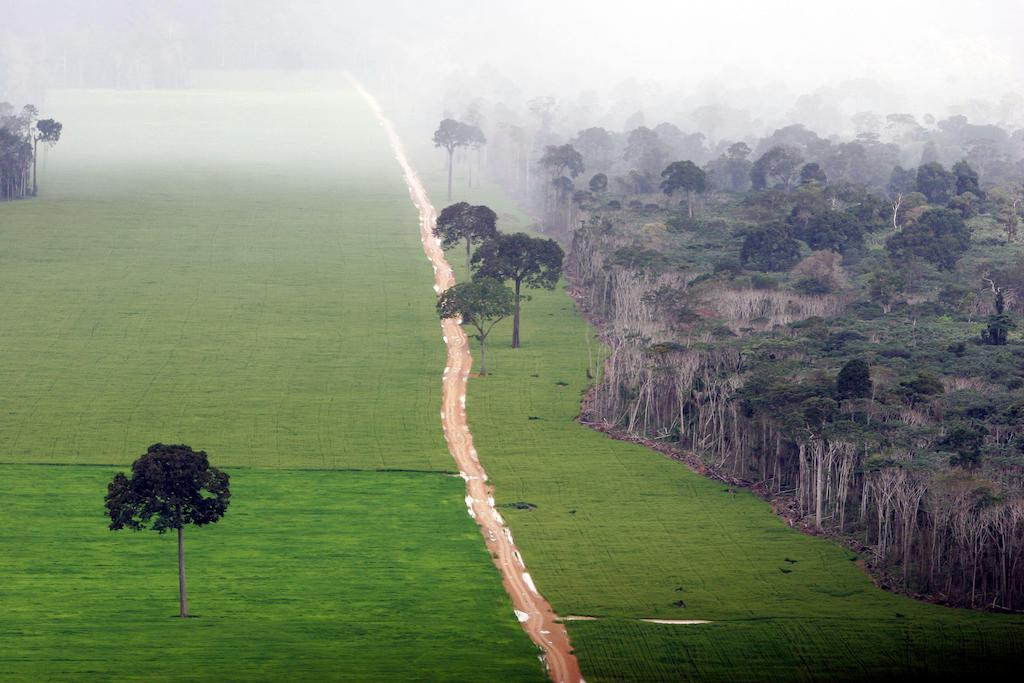
Changes over the past decade have benefited many landowners and the code has been poorly enforced under Bolsonaro.
Dr Aline Soterroni is the researcher who led the analysis, along with colleagues at the University of Oxford, the International Institute for Applied System Analysis and National Institute for Space Research (INPE) as part of the Agile, Nature-based Solutions and Oxford Net Zero Initiatives.
Soterroni tells Carbon Brief that under a baseline scenario in which the Forest Code continues being ignored, “annual deforestation rates in the Amazon are projected to stay above 10,000km2, on average, this decade”.
This can be seen in the chart below, with levels remaining at roughly the same level as they have been during Bolsonaro’s presidency so far. (The modelling runs from 2000 to 2050 in five-year steps. In the chart, model outputs were divided into years and begin from 2022.)
Soterroni notes that a slight dip in projected deforestation in the coming years can be attributed to modelling assumptions on technological changes and smaller growth rates in demand for Brazilian beef, soy and other products when compared to previous years.
Experts tell Carbon Brief that despite references to addressing illegal deforestation in his manifesto, there is little reason to think the Forest Code would be enforced under Bolsonaro. Carlos Rittl, a senior policy advisor at Rainforest Foundation Norway, says:
“If he remains in power in 2023, no one should expect that Bolsonaro’s war against the Amazon, Indigenous people, environmental legislation, including the Forest Code, and science to monitor forests and land use [to] change.
In fact, Rittl says that, in his view, a victory for Bolsonaro would likely see the pace of deforestation accelerate in the coming years, including “huge” areas beyond the scope of the Forest Code.
Forest Code observed
In contrast, while Lula was president between 2003 and 2010, the downward trend in deforestation has been attributed to an array of measures including improved satellite monitoring systems, new protected areas and enhanced enforcement of the Forest Code.
The second modelled scenario involves the full implementation of the Forest Code, including an end to illegal deforestation as well as restoration of illegally degraded areas and other measures to protect forests.
As the chart below shows, this sees deforestation levels drop by 89%, from 13,038km2 in 2021 to 1,480km2 at the end of the decade. In percentage terms, this is a comparable reduction to the one that took place during Lula’s last eight-year presidency.
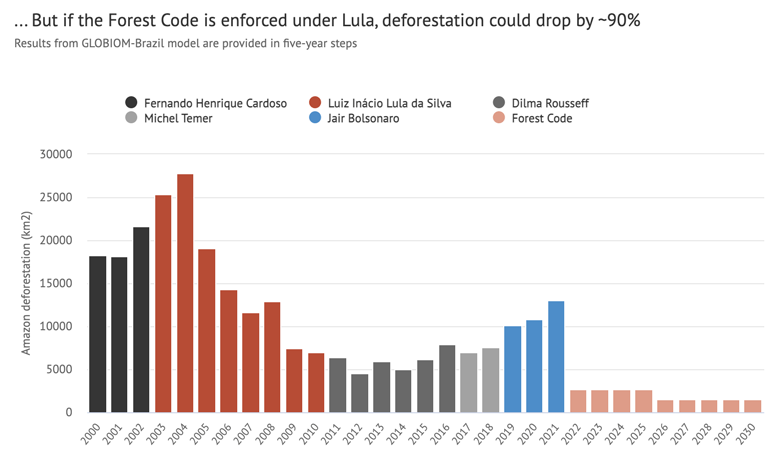
While they say complete enforcement could be difficult, experts are optimistic about Lula’s adherence to the Forest Code. Dr Grace Iara Souza, a fellow of the King’s College Brazil Institute, tells Carbon Brief:
“Lula has a track record of conservation and control policies from past mandates…There is hope that Lula’s government will be mindful of the global climate change and the Amazonian tipping point concerns and will restore the Forest Code.”
Rittl notes the recent reunion of Lula and his former environment minister Marina Silva, who oversaw much of his administration’s successes in the Amazon. The two politicians, who had fallen out in recent years, met to discuss “proposals for a more sustainable Brazil”.
There are many challenges facing a president wanting to curb illegal deforestation, not least the fact that much of it has been taking place on illegally occupied public lands subject to “land grabbing” in recent years. There has also been a surge in illegal gold mining on Indigenous lands under Bolsonaro.
Lula would also have to rebuild the nation’s environmental agencies and infrastructure, operating on the lowest environmental budget a Brazilian government has had in decades.
Dr Brenda Brito, an associate researcher at the research institute Imazon, tells Carbon Brief a sudden drop in deforestation, of the kind implied by the five-year intervals of the model, is unlikely:
“I think it’s more likely to expect a drop next year similar to the one observed between 2004 to 2005 (around 30%) and then higher cuts in the deforestation rate as the government reorganises the environmental institutions that were significantly weakened under Bolsonaro`s government and implement additional policies.”
Rittl concludes: “It won’t be an easy task. However, it would be an administration that would work for the enforcement of environmental laws, which includes the Forest Code.”
Source to sink
In total, the modelling covers the whole of Brazil, including changes across a variety of landscapes such as savannas, natural grassland and other ecosystems, as well as rainforests.
Many of the regions most vulnerable to farmland conversion – such as the central Cerrado region – are not, in fact, in the Amazon. Even in the Forest Code scenario, Soterroni notes that 330,000km2 of native vegetation would disappear by 2050, especially in the Cerrado and the north-eastern Caatinga region.
This can be seen in the maps below, which show the distribution of deforestation (red) and ecosystem restoration (green) across the whole 2021-2050 period the model runs for, under the baseline (left) and Forest Code (green) scenarios. It shows a particularly marked reduction in deforestation in the Amazon region in the north-west if the code is implemented.
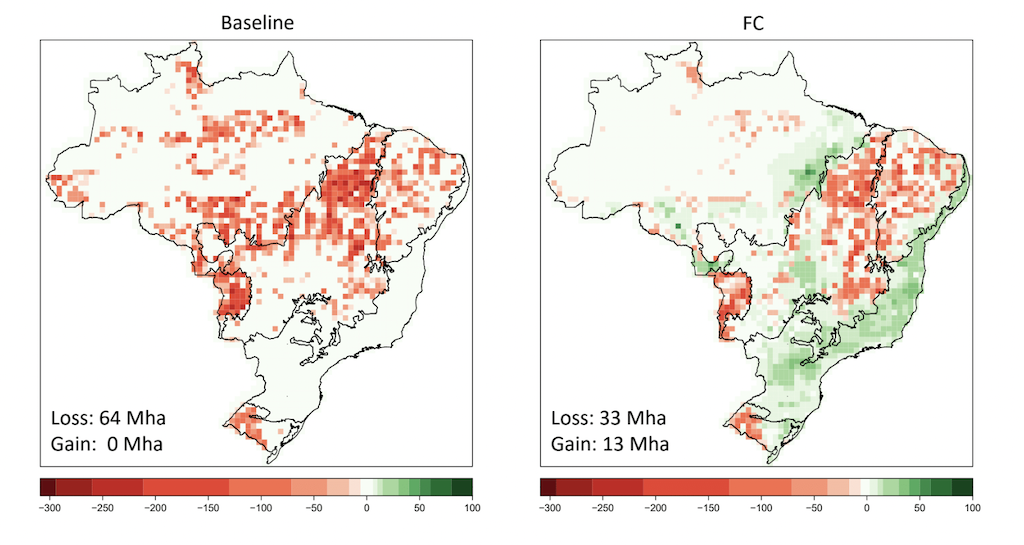
These changes would have significant implications for Brazil’s climate targets.
Bolsonaro has committed to a net-zero emissions target by 2050, but the credibility of this goal has been questioned. Experts have noted that Brazil’s land-use sector would be essential to achieving such a target, but the latest data suggests CO2 emissions from the Amazon under Bolsonaro have been double the average for the previous eight years.
In its analysis of total land-use emissions, which make up roughly one-third of Brazil’s total greenhouse gas emissions, the new modelling shows the impact of addressing deforestation and promoting ecosystem restoration.
The chart below shows land-use emissions across Brazil under the baseline scenario, with tree-planting (purple) offsetting a small amount of emissions but the sector remaining a net source out to 2050. Crucially, these numbers are higher than reality as they do not include carbon removals from native forests.
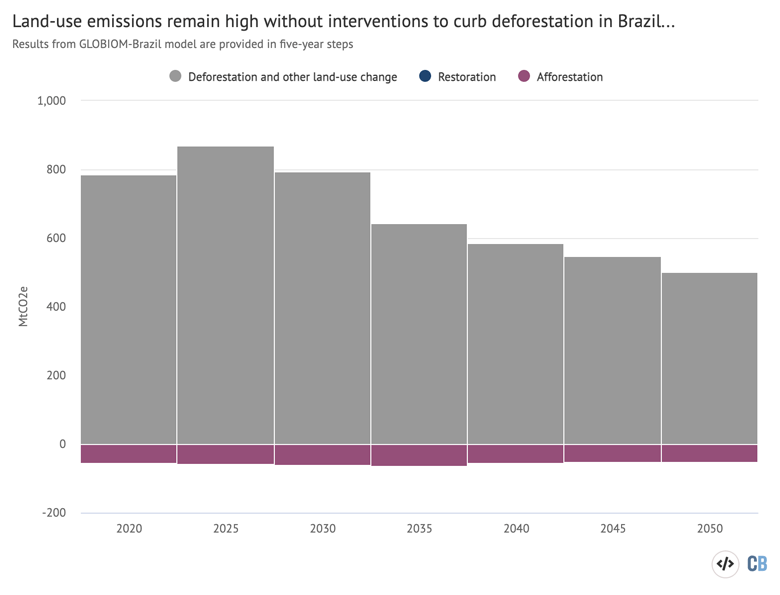
However, a very different picture emerges if the Forest Code is implemented, meaning landowners have to restore large areas that have been illegally deforested in the past.
As the chart below shows, emissions removals from the combination of ecosystem restoration and afforestation would be nearly cancelled out emissions from land-use change by 2035 and the sector would become a carbon sink by 2040.
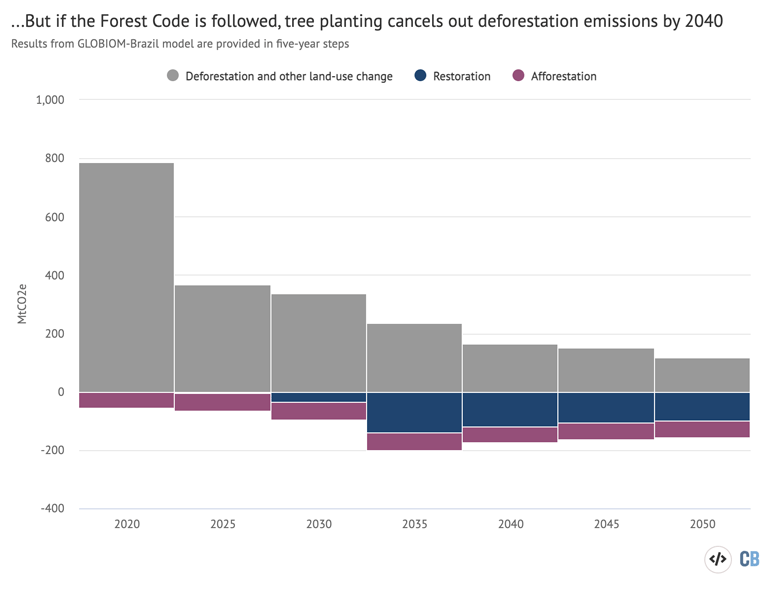
These results show the importance of the Forest Code and other measures to curb deforestation and enhance restoration, if Brazil is to stand a chance of achieving its net-zero target by the middle of the century.
-
Analysis: Bolsonaro election loss could cut Brazilian Amazon deforestation by 89%
-
Brazil election: Bolsonaro loss could see Amazon deforestation drop 89% by 2030





